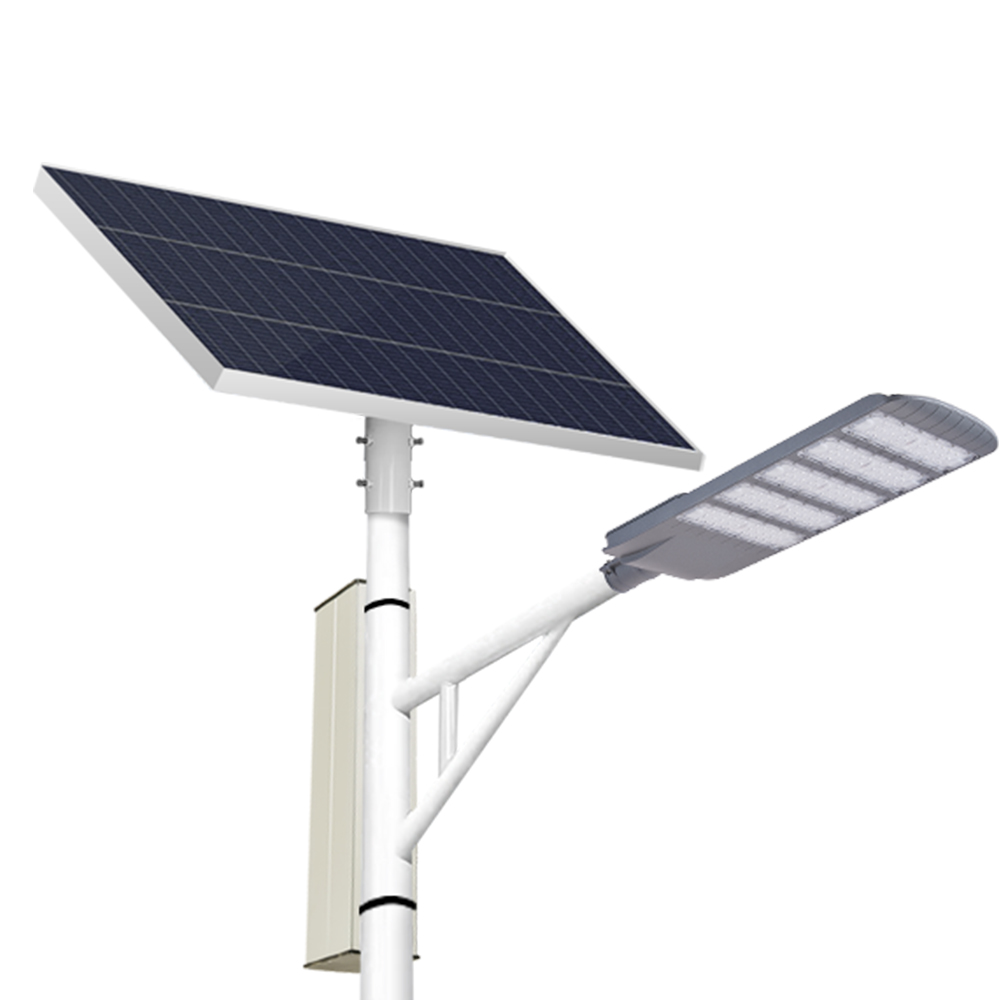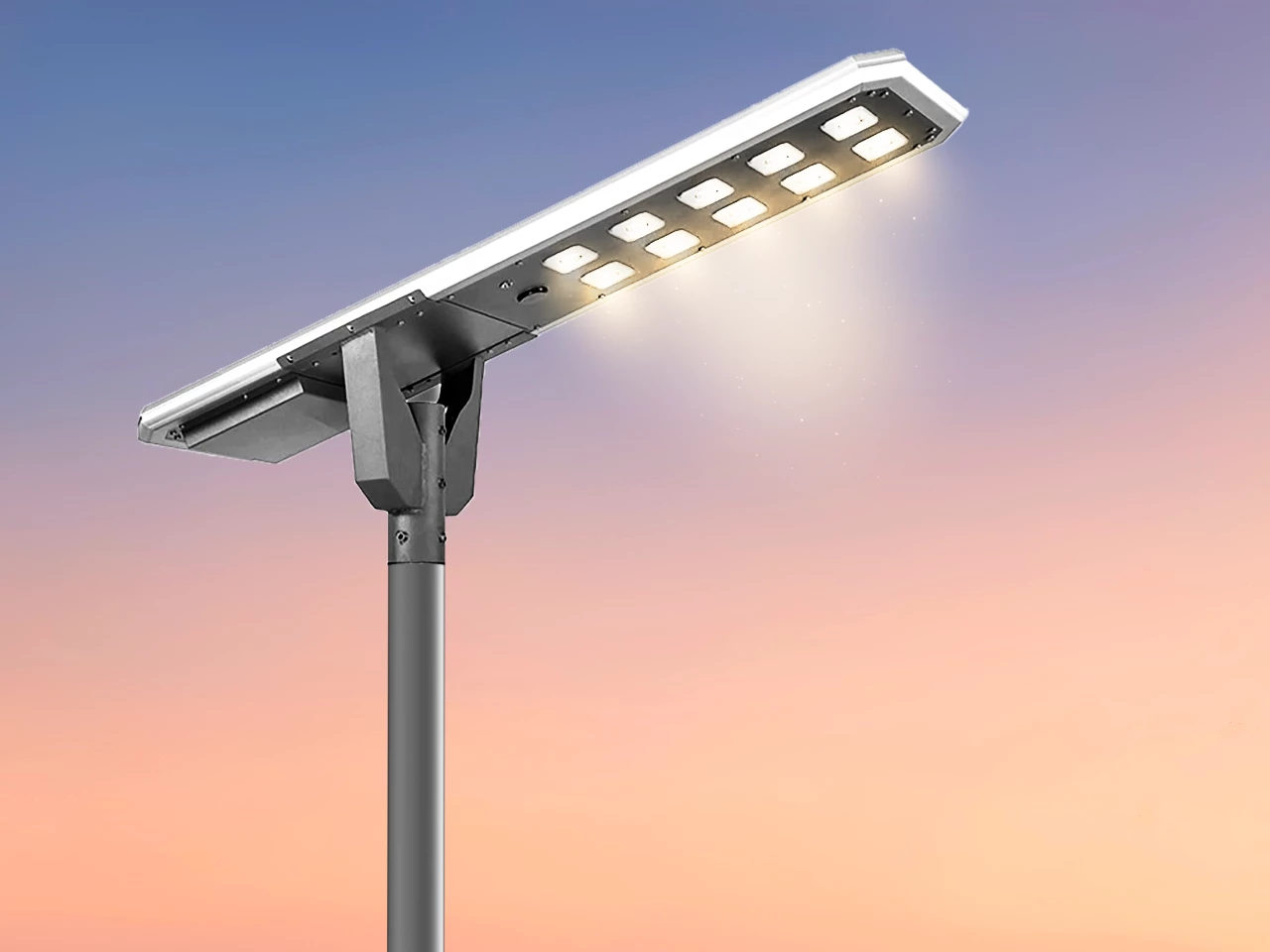Optimal Solar Street Light Configuration for 6m Pole and 6m Wide Road — Cost-Effective & Standard-Compliant
Discover the optimal solar street light configuration for 6-meter poles and 6-meter-wide roads. Learn how to meet Chinese lighting standards with cost-effective lighting design, spacing, and simulation.
Meet China’s National Lighting Standards with High Efficiency and Cost-Effectiveness
1. National Standard Reference (CJJ 45-2015)
| Road Type | Avg Illuminance (Em) | Uniformity (Ehmin/Em) |
|---|---|---|
| Secondary road / residential street | 10–15 lux | ≥ 0.25 |

2. Recommended Solar Street Light Configuration
- LED Lamp: 30W–40W, ≥160 lm/W, 4000K, Ra≥70, Type II lens
- Solar Panel: 90W–100W monocrystalline, ≥21% efficiency
- Battery: LiFePO₄ 12.8V 24Ah, 5–8 years life, 3–5 rainy days backup
- Controller: MPPT with light + timer control
- Design: Integrated, IP65+, 120° × 60° light beam
- Pole: 6m hot-dip galvanized steel, 140–160mm base, wind resistance ≥ Grade 10
3. Installation & Spacing Suggestion
- Installation: Single-side layout
- Tilt Angle: 5°–15°
- Recommended Spacing: 20–25 meters (optimal: 22 meters)
Simulation achieves 12–15 lux average illuminance with 0.28–0.35 uniformity, sufficient for pedestrian and bicycle safety.
4. Cost Estimation (USD)
| Component | Estimated Price (USD) |
|---|---|
| 30W LED Light | $18 – $25 |
| 100W Solar Panel | $28 – $35 |
| 24Ah LiFePO₄ Battery | $32 – $40 |
| MPPT Controller | $8 – $12 |
| 6m Steel Pole + Foundation | $45 – $60 |
| Total (Per Set) | $130 – $170 |
Note: Pricing varies by quantity, certifications (e.g., CE, UL, BIS), and shipping terms.
5. Optimization Tips for Cost-Effectiveness
- Use multi-mode dimming to save energy at night (e.g., 50% after midnight).
- Choose certified, durable components for lower maintenance cost.
- Incorporate modular design for easier replacements and upgrades.

6. Frequently Asked Questions (FAQ)
- Q1: Can this setup handle several days of cloudy weather?
- A: Yes, with a 24Ah battery, it supports 3–5 days of backup power under dimmed lighting modes.
- Q2: How often should the battery be replaced?
- A: LiFePO₄ batteries typically last 5–8 years under normal usage.
- Q3: Do the solar panels require cleaning?
- A: Yes, we recommend cleaning every 3–6 months to maintain optimal efficiency, especially in dusty regions.
- Q4: Is the illumination sufficient for pedestrians and bikes?
- A: Absolutely. The average illuminance of 12–15 lux meets Chinese standards for residential and minor roads.
- Q5: Can motion sensors or IoT be added?
- A: Yes, PIR sensors, NB-IoT, or LoRa modules can be integrated for smart control and remote monitoring.

Have more questions about our products or services?
The latest hot news you might like

Discover how solar panels power street lights, exploring the technology behind solar energy conversion, storage systems, and how solar-powered street lights are revolutionizing urban and rural lighting solutions.

Learn how AC Solar Hybrid Street Lights work, their advantages, disadvantages, system behavior in low-sunlight conditions, and why hybrid technology is ideal for regions with unstable sunlight.

Municipalities around the world are increasingly adopting solar-powered streetlights as part of their urban development strategies. Rising energy costs, the need for sustainable infrastructure, and government green initiatives are driving cities to switch from traditional street lighting to advanced LED solar streetlights.
Queneng Lighting provides municipalities with cost-effective, energy-efficient, and durable solar lighting solutions, ensuring safe and sustainable public spaces.

In recent years, the purchase of solar streetlights for municipalities has become a growing trend across the globe. Local governments are under pressure to reduce public expenditure, promote green energy, and create safer communities. Solar streetlights provide a reliable, cost-effective, and sustainable solution that meets these needs. Queneng Lighting, as a leading solar street lighting manufacturer, has supported multiple municipal projects worldwide with customized and energy-efficient solutions.
FAQ
Battery and Analysis
What are the main causes of rechargeable battery swelling?
2) The battery has no protection function and the cell expands;
3) The charger has poor performance and excessive charging current causes the battery to swell;
4) The battery is continuously overcharged by high rate and large current;
5) The battery is forced to over-discharge;
6) Issues with the design of the battery itself.
Distributors
Do you offer product training for distributors?
Yes, we provide in-depth product training, both online and in-person (when applicable), to ensure that you and your team are fully equipped with the knowledge needed to sell and support Queneng’s solar products.
Battery Performance and Testing
What is static resistance? What is dynamic resistance?
Commercial and Industrial Parks
What is the warranty for your solar lighting products?
We offer a 5-year warranty for the entire system and provide ongoing technical support.
Tourist Attractions and Resorts
Are solar lights bright enough for outdoor areas at night?
Yes, solar lights are designed to provide adequate brightness for outdoor areas such as pathways, gardens, and parking lots. Advanced solar technology ensures they provide sufficient lighting for safety and ambiance.
Public Gardens and Landscape Lighting
Can solar lights be customized for specific landscaping needs?
Yes, we offer customizable solar lighting solutions to meet the unique needs of different landscaping projects. From adjusting the brightness to selecting the appropriate lighting style and design, we can tailor our products to fit your vision.

If you would like more information about Queneng solar lighting solutions, please send us a message by filling out the form below. Our professional team will get back to you within 24 hours!
Rest assured that your privacy is important to us, and all information provided will be handled with the utmost confidentiality.
Schedule a Meeting

Book a date and time that is convenient for you and conduct the session in advance.
Have more questions about our products or services?



















